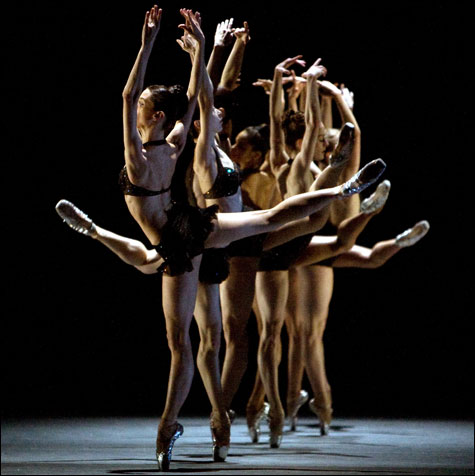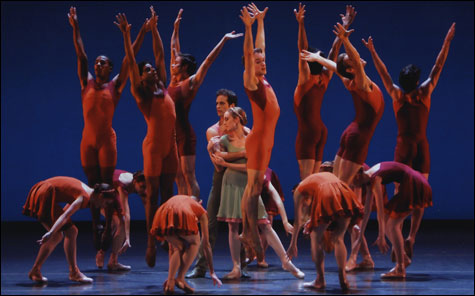
RABBIT AND ROGUE: In Twyla Tharp’s metaphysics, dancing can transform chaos into utopia. |
NEW YORK — Five minutes after the curtain came down on Twyla Tharp’s new ballet, Rabbit and Rogue, at the Metropolitan Opera House, a woman waiting for a bus was on the phone telling a friend to buy a ticket. “You have to see this!” she exclaimed. “This is the most phenomenal thing I’ve ever seen.” On the bus, another woman saw me looking over the program and asked what the story of the ballet was. Her friend thought it was an abstract ballet, and their discussion continued.
Next day the critics were savage, but it tells you something about a ballet when the audience leaves the theater with questions.
Tharp’s dances almost invariably have a euphoric effect on their first audiences, even when they miss their mark and don’t hold up over the long run. Rabbit and Rogue followed in the direction of her recent work, preserving the exhilarating, non-stop virtuosity she’s able to pull out of dancers, and sparking some speculation about “meaning” through her use of character devices.
Rabbit and Rogue, which premiered June 3 and ran for a week during American Ballet Theatre’s spring season at the Met, has two male leads, two secondary couples, a tertiary quartet, and a 12-member corps de ballet. It’s as formally structured as In the Upper Room or Tharp’s last ballet for ABT, Variations on a Themeby Haydn (2000), but it’s more than pure form. Tharp admitted in an interview that the leading men represent contrasting brothers, or the conflicting sides of one personality, but beyond that she wouldn’t elaborate on a private throughline that could encompass anything from dysfunctional families (hers, anyone’s) to cosmic evolution.
The surface of the ballet yields little help on that level, and though I might intuitively try to read her mind, during my one viewing I kept coming across a different set of markers. Early on, I realized that Danny Elfman’s gamelan-influenced score was insistently driving the dancers. The ceaseless momentum prevents you from being anything more than stunned, before the next stunning thing occurs. The whole stage seemed to be in perpetual motion, like a movie chase that never ends, only shifts camera locations.
Before the dance was done, I decided that Tharp was constructing the work with a movie editor’s technique, cutting back and forth from one set of characters to another. Each set plays its own role and sometimes interacts with the others, but what you pay attention to is the individual movement clusters, the dancing designs as they unfold. It’s like a TV serial, where three or four plot elements arise, break off, intersect, separate again, and maybe resolve, within an hour’s installment.
Rabbit and Rogue is never so literal, but Marcelo Gomes and Sascha Radetsky (I saw the second cast on Wednesday afternoon) seem to be genial antagonists, alternately punching each other out and facilitating each other’s phenomenal tricks. The other characters surge in and out like their aspirations and interrupted dreams.
In Tharp’s metaphysics, dancing can transform chaos (i.e., conflict, strife, opposing styles) into utopia (harmony, agreement, maturity). Always refashioned into new examples, this process keeps reappearing in her work, from Deuce Coupe (1973), the Tharp/Joffrey Ballet fusion work, to Push Comes to Shove (1976), her first ballet for ABT, and all the way to Movin’ Out (2002), the Broadway show.
Rabbit and Rogue, like much of Tharp’s career, spans a trajectory from the jazzy, brassy syncopations of the popular stage to the glamor of the silver screen. Norma Kamali’s costumes evolve from silver shoes and black neutrality to black-with-spangles to white and silver tights and swimsuits.
The Rag Couple (Kristi Boone and Cory Stearns) do rhythmic rags and slinky maxixes; they seem a bit coarse and argumentative. The Gamelan Couple (Maria Riccetto and Jose Manuel Carreño) are more decorous. They occasionally slow down, they do stretched-out tricky lifts and vertical jumps. Each aspect is echoed by units of the ensemble.
Toward the end, the music consolidates into a stately processional, like the wedding at the end of Firebird, and after a man from the corps seems to referee the differences between Rabbit and Rogue, the corps gathers in a curtain pose, with the women in decorative lifts, and the leading men reach accord at last — but face away from each other.

CONCERTO DSCH: Alexei Ratmansky’s groups are composed of individuals who know they belong
together, and they behave with easy sociability. |
Over at the New York State Theater, Alexei Ratmansky has made another fine new work for New York City Ballet. The unpronounceable title Concerto DSCH refers to a musical motif Dmitri Shostakovich used as a signature; the ballet is set to his Second Piano Concerto. Like Tharp’s work, the Ratmansky is a pure-dance ballet, with wonderful opportunities for wonderful dancers and not much dramatic distraction. Where her dance is relentless and almost choked with activity, his is asymmetrical but spacious, often fast but somehow unhurried. His groups are composed of individuals who know they belong together. Her groups are individuals who remain separate but agree on tenuous solutions.We might think we know the contrasting qualities of ballerinas Wendy Whelan and Ashley Bouder, but Ratmansky reveals something more about them and about dancing. In a duet with Benjamin Millepied, Whelan makes the cliché of falling backwards into his arms seem to have a reason that’s not necessarily ecstatic surrender. Bouder sprinkles sudden jumps into an allegro solo, and later she seems to be gently guiding her partner’s leaps. I wasn’t sure which of her competing suitors (Joaquin de Luz and Gonzalo Garcia) she was helping, but it was an original idea about partnering that distinguished the moment.